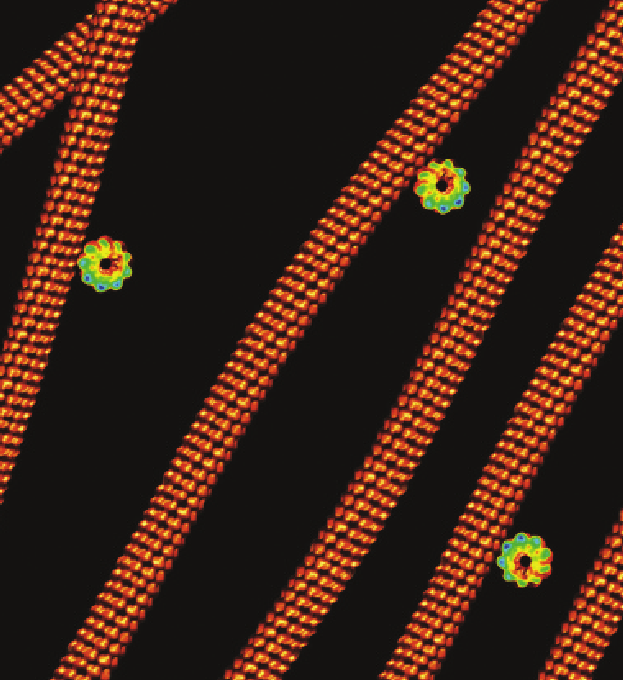
Viruses are extremely successful at finding ways to circumvent just about every host defense system. The secrets to this success seem to lie in their simplicity—small genomes and a metabolism that relies in part on the biochemistry of the host— and in their elegant, often breathtakingly beautiful and highly functional structures. Viral architecture, especially the coat protein structure, is intricately intertwined with successful invasion and infection of the host. Yet for many viruses, and particularly for a very large group of plant viruses, details of their structures have remained elusive. But researchers using a high-brilliance x-ray beamline at the APS have obtained important details about the structures of a soybean and a potato virus. This is good news for crop scientists concerned with finding ways to combat viral infestations.
Over the years, scientists have has invested much time and effort searching for methods to learn more about the structures of flexible filamentous viruses. By doing so, they hoped to find ways of combating the economic devastation resulting from crop loss due to viral infestations. The researchers in this study, from Vanderbilt University, the Boston University School of Medicine, the Illinois Institute of Technology, the University of Kentucky, and Brookhaven National Laboratory, used a variety of techniques, including fiber diffraction data collected on the BioCAT beamline 18-ID at the APS, to determine that the viruses they studied, and by extension most flexible filamentous viruses, have similar coat protein folds and helical symmetry, with a little less than nine subunits per helical turn. This new knowledge marks great progress in understanding how these plant viruses operate and will help scientists figure out how to outsmart the viruses and prevent viral infections.
The research team determined the symmetry and low-resolution structures of a potyvirus (soybean mosaic virus), and a potexvirus (potato virus X). These viruses represent the two largest families of flexible filamentous viruses, the Potyviridae and the Flexiviridae. Together with some smaller families, they make up the largest group of plant viruses. These viruses are of enormous economic importance. Members of the potyvirus family account for half of the viral crop damage worldwide, but their structures had proved difficult to characterize because of such factors as flexibility, instability, and low levels of expression. The variety of methods the research team employed—fiber diffraction at the BioCAT beamline, cryoelectron microscopy (cryo-EM), and scanning transmission electron microscopy (STEM)—allowed them to overcome these problems and to finally produce structural data.
The researchers obtained, for the first time, well-oriented fiber diffraction data from a potyvirus. They then used these data to determine radial density and, when combined with the STEM and cryo-EM data, viral symmetry. The cryo-EM, together with the fiber diffraction data, allowed the group to determine the overall viral structure and produce a reconstructed image that showed the subunit shape and arrangement in this potyvirus (Fig. 1).
For comparison, the group then went on to study the structure of potato virus X at a comparable resolution and to confirm the previously characterized symmetry of this virus. The structures and symmetries of the two viruses were unexpectedly similar, suggesting that these two virus families, the Potyviridae and the Flexiviridae, are structurally related.
The latter result is surprising in that previous work showed little similarity in the proteins making up the coats of these viruses. Now that good structural data are available, however, the evidence points to similarity and evolutionary relationships between soybean mosaic virus and potato virus X, and by implication among all flexible filamentous plant viruses. This is good news to crop scientists concerned with finding ways to combat viral infestations. It means that when an anti-viral treatment based on viral structure works against one virus, there is a good chance it will work on others in this group. How viruses so successfully infest plants has just become a little less secretive.
See: Amy Kendall, Michele McDonald, Wen Bian, Timothy Bowles, Sarah C. Baumgarten, Jian Shi, Phoebe L. Stewart, Esther Bullitt, David Gore, Thomas C. Irving, Wendy M. Havens, Said A. Ghabrial, Joseph S. Wall, and Gerald Stubbs, “Structure of Flexible Filamentous Plant Viruses,” J. Virol. 82(19), 9546 (October 2008). DOI: 10.1128/JVI.00895-08
This work was supported by National Science Foundation grant MCB-0235653 to G.S. and USDA-NRI grant 2006-01854 to S.A.G. Fiber diffraction data analysis software was from FiberNet (www.fiberdiffraction.org), supported by NSF grant MCB0234001. BioCAT is an National Institutes of Health-supported Research Center (RR08630). Use of the Advanced Photon Source was supported by the U.S. Department of Energy, Office of Science, Office of Basic Energy Sciences, under Contract No. DE-AC02-06CH11357.
Based on an APS press release by Mona Mort.